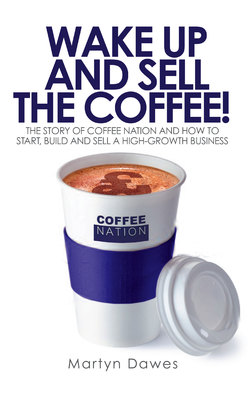Читать книгу Wake Up and Sell the Coffee! - Martyn Dawes - Страница 27
На сайте Литреса книга снята с продажи.
Sales progress but on borrowed time
ОглавлениеMy two highest performing Spar sites were in Manchester so these were next in line for my new offer. Together with Faversham and Edinburgh that gave me my four new test sites. The cash burn resumed as I now had to buy those pricey espresso machines and have three more concession units constructed.
I was back on a steep learning curve, operating this new type of product. It was far from perfect. The concession unit was made of MDF, which wasn’t terribly robust, particularly if it got wet with coffee spills. The espresso machine was a pig to clean, with fiddly parts that had to be removed. The milk was kept cold in a small separate fridge with a pipe going into the coffee machine. If the machine wasn’t cleaned exactly as per schedule and that pipe flushed with cleaner then I would soon have milk solidifying at room temperature in the pipe. Not good for the product or the consumer!
The coffee machine was really designed for use in a cafe and so had steam and water pipes (for frothing milk and boiling water for tea) that I didn’t need. Remarkably, dispensing simple items like stirrers and lids was a nightmare as they were fiddly and difficult to stack. Despite the challenges, I had a strong feeling that I was going in the right direction and nobody was ahead of me.
By September the four re-fitted espresso machine sites were all operating and we were selling up to 800 cups per month from each machine. This was great news, but of course the costs were now much higher. I started to increase the drink price, first to 75p and then up to 99p. I was far too timid and cautious with pricing but eventually the market did the talking for me; on the high street a cappuccino was now at £1.50 so I could afford to charge more.
There was no doubt I had the makings of a proven proposition for the consumer, but I had not quite reached true commercial viability. The cost of an installation was now £5000, versus the £1500 I had paid for each instant coffee machine.
I started to give serious consideration to the possibility that I now had the offer right but the wrong locations. Perhaps this concept really lived in much higher volume locations like busy petrol forecourts, motorway services and supermarkets?
A short summary I had prepared on the business had been sent out by Baker Tilly to a targeted collection of venture capitalists. The answers were consistent. They either thought my business was too early stage to invest in or questioned if it would be profitable enough to make a return for a VC. I was making progress but was it quick enough? Would I raise some proper investment for this business before the patience of Barclays ran out and they called in my overdraft?
The need to conserve cash whilst I figured out how to secure investment was severe. I had to let Lou go. I could now see I had employed him way too early, when I thought that success would simply be a question of following what I had written in my business plan. I didn’t need any employees – I just needed to run a small test market of my new gourmet coffee machines and find the right investor. He had been so loyal and believed in Coffee Nation and me without doubt. He took the decision well.
At about that time I reconnected with Tony, who I had met at an Institute of Directors networking event a couple of years earlier. He ran a small advisory firm, mostly focused on company turnarounds and distressed businesses and I asked his view. Simple, he said. I needed a new business plan and then had to secure some proper funding.
